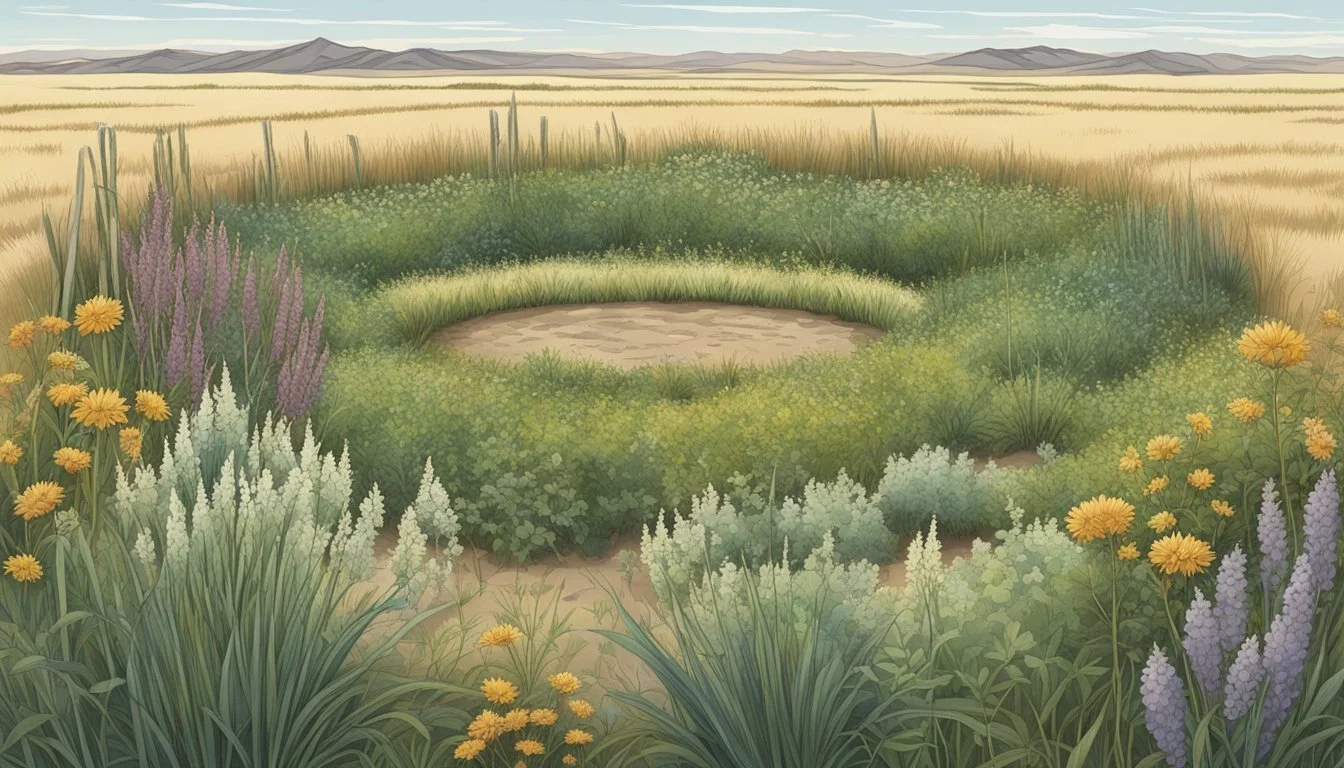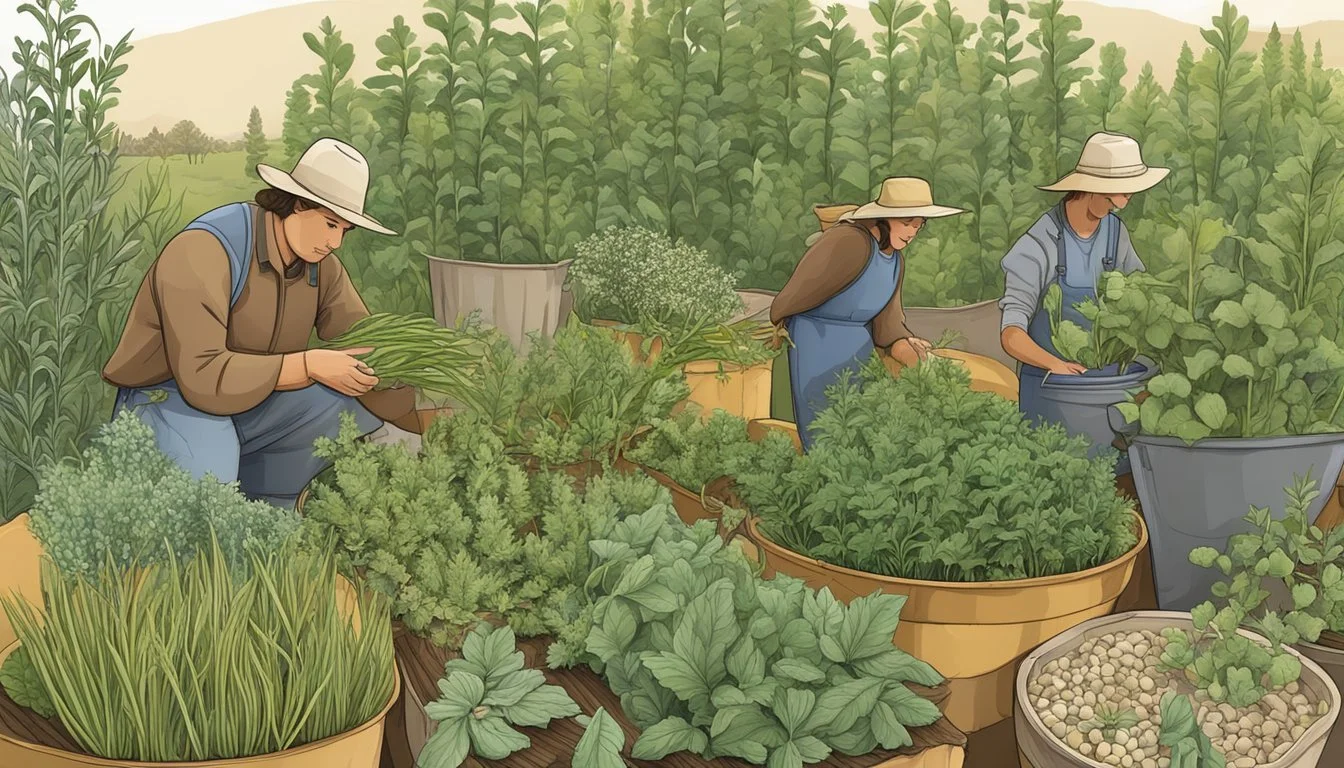Great Plains Native Edible Plants
A Guide to Foraging and Uses
Stretching across North America, the Great Plains boast a remarkable array of native edible plants that have sustained indigenous peoples for centuries. These plants are not only a testament to the rich biodiversity of the region but also to the deep knowledge and resourcefulness of its early inhabitants. From the starchy prairie turnip (Psoralea esculenta), known as Thíŋpsiŋla, to the nutty American groundnut (Apios americana), the Great Plains offer a variety of plants that can still be foraged and enjoyed today.
The prairie turnip, thriving in dry patches of the Great Plains, and the American groundnut, commonly found in wetter areas, are just the beginning of the region's natural pantry. Each plant provides unique flavors and nutritional benefits, making foraging an exciting and rewarding activity. These edible treasures not only serve as a link to the past but also offer a sustainable and nutritious food source for the present.
Embracing the edible bounty of the Great Plains connects us to a tradition that values the land and its natural gifts. Whether you're interested in the historical uses of these plants or their culinary potential, discovering the native edible plants of the Great Plains is a journey worth embarking on.
Historical Significance
Edible plants of the Great Plains played a crucial role in the lives of indigenous peoples and settlers, functioning as sources of food, medicine, and forage. Among these plants, the prairie turnip and chokecherry hold significant historical importance.
Indigenous Uses
Native American tribes extensively relied on plants like the prairie turnip (Psoralea esculenta) and bison for sustenance and medicinal purposes. The prairie turnip, known as Thíŋpsiŋla among the Lakota, was a vital starchy tuber that could be stored and consumed year-round.
Corn, another staple, was often mixed with beans and squash, forming the “Three Sisters” agricultural system that provided a balanced diet. Chokecherry (Prunus virginiana) was another essential plant, celebrated during the Black Cherry Moon when tribes would gather to harvest and dry the berries, later mixing them with bison meat to prepare pemmican.
These plants also served medicinal roles. For instance, the plains sunflower was utilized for its seeds and oil, and certain plants were used for treating ailments, making them indispensable in the daily lives of indigenous communities.
Settler Adaptation
European settlers arriving in the Great Plains quickly adapted many of the indigenous practices. The prairie turnip became known as the prairie potato, and its hardiness and nutritional value made it a popular supplementary food source.
Settlers learned to forage for wild plants like the wild plum (Prunus Americana), which thrived in the region and became a favored fruit. The adaptation also extended to using native plants for forage, as the settlers' livestock benefited from the nutritious native grasses.
Plants provided by Native Americans were also integral in creating new varieties of food staples that could withstand the harsh Plains environment. This exchange of knowledge ensured that essential aspects of indigenous agricultural practices were preserved and integrated into European American diets.
Botanical Overview
Great Plains native edible plants exhibit a wide variety of types and species, each with unique defining characteristics. This diverse flora includes plants that have adapted to prairie ecosystems and habitats, offering nutritional and medicinal benefits.
Plant Types and Species
The Great Plains region is home to over 3,000 plant species, with more than 120 used historically by Native Americans for food and medicine. Some notable examples include Apios americana (American groundnut) and Psoralea esculenta (prairie turnip). These plants thrive in wet prairie areas and Eastern woodlands.
American groundnut, which resembles baby potatoes in taste, could be eaten boiled, roasted, fried, or raw. Prairie turnip, rich in nutrients, was often stored for winter use.
Other native edible plants include wild onions, wild garlic, and various berries such as chokecherries and buffalo berries. Each plant has its specific habitat and ecological niche, contributing to the biodiversity of the Great Plains.
Defining Characteristics
One defining characteristic of Great Plains native plants is their adaptability to different prairie ecosystems. These plants often have deep root systems that enable them to survive in diverse soil types and varying moisture levels.
For example, prairie turnip has a thick, fleshy root that stores water, making it resilient during droughts. Similarly, the American groundnut thrives in moist environments but can also endure less favorable conditions due to its robust root system.
The leaves, flowers, and fruits of these plants often have distinct characteristics that aid in identification. For instance, the American groundnut has clusters of small, purple flowers, while the prairie turnip has delicate, bluish-purple blooms. Their adaptability and resilience make these plants vital to the prairie ecosystem and invaluable to human use.
Nutritional Profiles
The edible plants of the Great Plains offer a wealth of nutrients that support health and well-being. These plants provide essential macronutrients, vitamins, and minerals.
Macronutrients in Plains Flora
Native edible plants of the Great Plains, such as the prairie turnip (Timpsila/Psoralea esculenta), are significant sources of both protein and carbohydrates. The prairie turnip, for instance, is rich in starch, providing sustained energy.
Other plants like chokecherry (Prunus virginiana) offer modest amounts of proteins and dietary fiber, supporting digestion and metabolic health. It's important to consider the macronutrient compositions of these plants, as they have historically formed the basis of indigenous diets and continue to offer vital nutritional benefits.
Vitamins and Minerals
Great Plains native plants are also rich in essential vitamins and minerals. For example, chokecherries are a notable source of Vitamin C, which is crucial for immune function and skin health.
These plants often contain important minerals such as iron, found abundantly in many wild berries and roots. Iron is essential for blood health and energy levels. The nutritional properties of these plants help address various health needs, promoting overall well-being.
Incorporating plants like these into one's diet can provide diverse and balanced nutrition, contributing to long-term health benefits.
Culinary Applications
Traditional and modern culinary applications of Great Plains native edible plants demonstrate their versatility and nutritional benefits. These preparations highlight traditional methods that have been passed down through generations and innovative modern uses that incorporate these plants into contemporary dishes.
Traditional Preparations
Native American tribes of the Great Plains utilized various methods to prepare and preserve edible plants. Prairie turnips (timpsila) were commonly dried and ground into flour. This flour was then used to make breads, cakes, and thickening agents for stews. Bison meat was often combined with turnips in soups.
Berries, such as wild blueberries and chokecherries, were used to make jams, pies, and pemmican – a mixture of dried meat, fat, and berries. Wild onions and other roots were boiled and added to dishes for flavor. These traditional techniques ensured that food could be preserved and enjoyed throughout the year.
Modern Usage
In contemporary cuisine, there is a resurgence of interest in using native plants from the Great Plains. Prairie turnip flour is used as a gluten-free alternative in baking. Chefs incorporate it into breads, pancakes, and sauces. Boiled and mashed, timpsila adds a unique flavor to modern recipes.
Foraged berries like wild blueberries are utilized in gourmet dishes such as compotes, sauces for meats, and desserts. Dandelion greens and other wild greens are incorporated into salads, adding a nutritious boost. There is also interest in using native plants to create artisanal products like wines and craft flours, showcasing the diverse potential of these traditional ingredients.
Foraging and Harvesting
Understanding how to identify and sustainably harvest native plants is vital for Great Plains foragers. Prioritize correct identification techniques and conservation to ensure continuous availability of these natural resources.
Identification and Gathering
Correct identification is critical to safe foraging. Foragers should familiarize themselves with distinctive features of native plants such as Milkweed (Asclepias spp.), Prairie Turnip (Psoralea esculenta), and various wild berries.
Milkweed can be recognized by its tall shoots and clusters of pink flowers. The Prairie Turnip has a starchy taproot, found about four inches beneath dry, open areas. Wild berries, often found in bushy areas, should always be double-checked against a reliable guide to avoid toxic look-alikes.
Using field guides or mobile apps can help improve identification accuracy. Local workshops or nature walks led by experts also serve as valuable resources for beginner foragers.
Sustainable Practices
Sustainable harvesting ensures the continued growth and availability of native plants. When gathering plants like Milkweed, foragers should only collect young shoots, ensuring some are left to mature and seed. This practice maintains the plant population and supports local ecosystems.
Avoid overharvesting by following the "one-third rule" – take only one-third of the plant's parts, leaving the rest to regenerate. For fragile species like the Prairie Turnip, responsible methods include digging carefully around the root to minimize soil disturbance.
Engaging in conservation efforts, such as planting native species in personal or community gardens, supports the overall health of Great Plains flora. Foragers should always respect protected areas and follow regional guidelines to promote sustainable foraging.
Cultural Significance
The native edible plants of the Great Plains have played a crucial role in the lives of the Indigenous peoples, providing food, medicine, and spiritual value. These plants held central positions in rituals, legends, and everyday practices, reflecting a deep connection with the natural environment.
Native American Tribes
The Lakota and Dakota tribes, among other Plains Indian tribes, relied heavily on native plants like the prairie turnip (Thíŋpsiŋla or Psoralea esculenta) and chokecherry (Prunus virginiana). These plants were essential not just as food sources but also for their medicinal properties.
For instance, the Lakota used chokecherries in pemmican production, mixing them with bison meat for a nutritious meal. The prairie turnip, another staple, was consumed for its high starch content and was often dried for preservation during nomadic travels.
Rituals and Traditions
Plants held a vital role in rituals and traditions, reflecting both practical uses and spiritual beliefs. The Dakota people named the first full moon after the Summer Solstice as the Black Cherry Moon, a period dedicated to gathering and drying chokecherries. This practice highlights both the agricultural and social importance of the plant.
Sunflowers, another key plant, were used for their seeds and oil. In several tribes, they symbolized the sun and were involved in sun-related rituals. Medicinal uses of plants were intertwined with spiritual practices, where specific plants were used in healing ceremonies. Legends and stories often featured these plants, underlining their importance in cultural narratives.
Conservation Efforts
Conservation efforts for native edible plants of the Great Plains focus on protecting native species and undertaking ecological restoration initiatives to maintain biodiversity and support local ecosystems.
Protection of Native Species
Efforts to protect native species involve legal frameworks and community-led initiatives. Wildlife agencies enforce regulations that prohibit the overharvesting of plants like the prairie turnip (Thíŋpsiŋla) and American groundnut (Apios americana).
Local tribes play a crucial role by sharing traditional practices that ensure sustainable harvesting methods. Educational programs raise awareness about the importance of preserving these native species and their historical significance to the Great Plains’ ecosystem.
Organizations frequently monitor plant populations, using scientific surveys to assess the health of native plant communities.
Ecological Restoration
Ecological restoration aims to revive habitats and enhance biodiversity. Reforestation projects plant native species to restore prairies and woodland areas. Techniques such as controlled burns and invasive species removal help maintain the balance within these ecosystems.
Habitat restoration efforts seek to re-establish the natural environments that support wildlife. Seed banks and native plant nurseries grow and reintroduce native plants, such as milkweeds and wild prairie turnips, into their original habitats.
Collaborations between environmental organizations and local communities ensure that restoration practices are sustainable and permanent, facilitating long-term ecosystem conservation.








